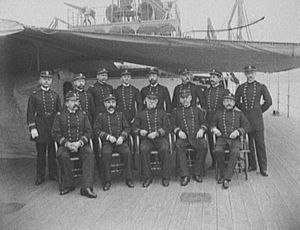- Montgomery Sicard
-
Montgomery Sicard 
Born September 30, 1836
New York CityDied September 14, 1900 (aged 63)
Westernville, New YorkAllegiance  United States
United StatesService/branch  United States Navy
United States NavyYears of service 1851–1898 Rank Rear Admiral Commands held Seneca
Pensacola
Saginaw
North Atlantic SquadronBattles/wars American Civil War
Spanish–American War Captain Sicard and the officers of the USS Miantonomoh
Captain Sicard and the officers of the USS Miantonomoh
Rear Admiral Montgomery Sicard (30 September 1836 – 14 September 1900) was an officer in the United States Navy during the American Civil War.
Contents
Biography
Born in New York,[1] Sicard was appointed acting-midshipman on 1 October 1851.[2] After graduation from the Naval Academy[1] he was made midshipman on 9 June 1855.[2] He was then attached to the frigate Potomac (1855–6) and steam frigate Wabash) (1856–9) in the Home Squadron,[3] and was promoted to passed midshipman on 15 April 1858, and to master on 4 November 1858.[2]
Receiving his commission as lieutenant on 31 May 1860,[2] he served aboard the steam sloop Dacotah in 1861, and on the steam sloop Oneida of the West Gulf Blockading Squadron in 1862-3,[3] participating in the capture of New Orleans, Louisiana, late in April 1862;[1] seeing action in the bombardment and passage of Forts Jackson and St. Philip, at the Chalmetto batteries, and in the destruction of rebel flotilla and transports on 24 April 1862,[3] and in the passage of the Vicksburg batteries in June.[1] He was present when the Confederate ram CSS Arkansas made an attack on the Union Fleet on 15 July 1862, receiving his commission as lieutenant commander the next day.[3] Sicard commanded the Seneca during the two assaults on Fort Fisher in December 1864 and January 1865,[1] and saw further action at the bombardment of Fort Anderson on 11 February 1865. Sicard then served aboard the steam sloop Ticonderoga on the South Atlantic Blockading Squadron until the war's end.[3]
Sicard was an instructor at the Naval Academy from 1866–8, and commanded the steam sloop Pensacola in the North Atlantic Squadron in 1868-9. He then took command of the steamer Saginaw in the Pacific Squadron,[3] and was promoted to commander on 2 March 1870.[2] On 30 October 1870 the Saginaw was wrecked after running aground on Kure Atoll. The shipwrecked sailors salvaged supplies from the ship, and five men, led by Lieutenant John G. Talbot, set out in a small boat for the Hawaiian Islands some 1,500 miles (2,400 km) away. Arriving at Kauai after 31 days, the boat overturned in the breakers, and only Coxswain William Halford survived. King Kamehameha V sent his steamer Kilauea to rescue the stranded sailors, all of whom survived.[4]
Command duty afloat then alternated with ordnance duty in Washington, D.C. and New York City.[1] Sicard was promoted to the rank of captain on 7 August 1881,[2] and served as Chief of the Bureau of Ordnance from 1881 to 1890.[1] He was promoted to commodore on 10 July 1894,[2] to rear admiral on 6 April 1897,[2][5] taking command of the North Atlantic Squadron. He was forced to relinquish his command at the outbreak of the Spanish–American War due to ill health. Upon his partial recovery, he was placed in charge of the Board of Strategy and took an important part in guiding the conduct of the war.[1]
Rear Admiral Sicard retired on 30 September 1898, and died at Westernville, New York, on 14 September 1900.[1]
Namesake
The destroyer USS Sicard (DD-346) (1920–1945) was named for him. The Washington Navy Yard in Washington, D.C. also has Sicard Street which is named for him.
See also
References
- ^ a b c d e f g h i "Sicard". Dictionary of American Naval Fighting Ships. Navy Department, Naval History & Heritage Command. http://www.history.navy.mil/danfs/s12/sicard.htm. Retrieved 5 November 2010.
- ^ a b c d e f g h "US Navy Officers: 1778–1900 (S)". history.navy.mil. http://www.history.navy.mil/books/callahan/reg-usn-s.htm. Retrieved 5 November 2010.
- ^ a b c d e f Lewis Randolph Hamersly (1870). "The records of living officers of the U.S. Navy and Marine Corps: with a history of naval operations during the rebellion of 1861–5, and a list of the ships and officers participating in the great battles". archive.org. http://www.archive.org/stream/cu31924098819968/cu31924098819968_djvu.txt. Retrieved 5 November 2010.
- ^ Jan TenBruggencate (October 18, 2003). "Historic Hawai'i wreck found". The Honolulu Advertiser. http://the.honoluluadvertiser.com/article/2003/Oct/18/ln/ln06a.html. Retrieved 5 November 2010.
- ^ "NOMINATED BY THE PRESIDENT. Commodore Montgomery Sicard for Rear Admiral in the Navy". The New York Times. 8 April 1897. http://query.nytimes.com/mem/archive-free/pdf?res=9C04E1DF163DE433A2575BC0A9629C94669ED7CF. Retrieved 5 November 2010.
- This article includes text from the public domain Dictionary of American Naval Fighting Ships. The entry can be found here.
Further reading
- George H., Read (1912). The Last Cruise Of The Saginaw. Boston & New York: Houghton Mifflin Company. http://www.gutenberg.org/files/32170/32170-h/32170-h.htm.
- Tucker, Spencer C. (2009). The encyclopedia of the Spanish-American and Philippine-American Wars. Volume 1. Santa Barbara, California: ABC-CLIO. p. 591. ISBN 9781851099511. http://books.google.com/books?id=8V3vZxOmHssC&pg=PA591.
Categories:- 1836 births
- 1900 deaths
- United States Navy admirals
- Union Navy officers
- People of New York in the American Civil War
- United States Naval Academy alumni
Wikimedia Foundation. 2010.

